
Table of Contents
WHAT IS UNIVERSAL HEALTH COVERAGE (UHC)?
- Universal Health Coverage (UHC) means, “Every person, everywhere, has access to quality health care without suffering financial hardship’ (UniversalHealthCoverageDay.org)
- Who: All people including the poorest and most vulnerable
- What: full range of essential services, of good quality
- How: reducing out of pocket expenses through cost sharing (pre-payment and risk pooling)
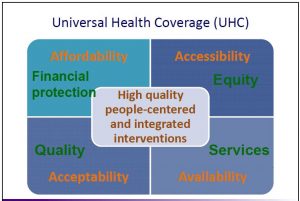
- World Health Organization (WHO) defines UHC as a “Health care system with a motive of equity in access through promotive, preventive, curative and rehabilitative health interventions.”
HISTORY OF UHC:
- UHC is firmly based on the WHO constitution of 1948 declaring health a fundamental human right and on the Health for All agenda set by the Alma Ata declaration in 1978.
- The concept of UHC was generated in 2005 with an aim to ensure access to the health services they require without risk of financial ruin or impoverishment which was made as a commitment by member countries.
- The commitment was reaffirmed in 2012 through a resolution of the United Nations General promoting universal health coverage, including comprehensive primary health care, social protection, and sustainable financing.
- Achieving UHC is one of the targets the nations of the world set when adopting the Sustainable Development Goals in 2015.
WHAT UHC IS NOT?
- Does not mean free coverage for all interventions, regardless of the cost, as no country can provide free services.
- Is not about health financing and it encompasses all components of health system: health service delivery systems, the health workforce, health facilities and communications networks, health technologies, information systems, quality assurance mechanisms, and governance and legislation
- Is not only about ensuring a minimum package of health services, but also ensuring progressive expansion of health services and financial protection as more resources become available
- Is not about individual treatment facilities, but includes a population based service provision.
- It is more than just health comprising of other factors like equity, development priorities, social inclusion and cohesion.
DIMENSIONS OF UHC:
There are three main dimensions of UHC i.e. population, services and direct costs. These dimensions allocated by WHO provides a picture to show that the coverage is done mainly for:
- Population coverage: Extend services to the population which have not yet been addressed.
- Health services coverage: Include other areas where the health facilities have not reached yet.
- Financial Coverage: Reduce the cost sharing and fees while obtaining health services
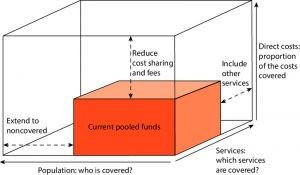
The main approaches that have been done to achieve the UHC includes:
- Equitable health services: Provide all population and people with equal access and availability of the health services.
- Quality health services: The services must contain good quality to enhance and promote services
- Multisectoral co-ordination: Including collaboration with the governmental, local, private and other sectors for effective outreach of health services.
- Health system reform: There should be a central change in the system mentioning UHC as its target of achievement.
OBJECTIVES OF UHC:
- Equity to health services: For those who need the services should be able to get them and not just one who can pay for them.
- The quality of health services: The services is good enough to improve health of those receiving the services
- Financial Risk protection: Ensuring that cost of using care does not put people at risk of financial hardship.
GUIDING PRINCIPLES FOR UHC:
- Universality: broader coverage all around.
- Equity: Service for one who needs it
- Non-exclusion and Non-discrimination.
- Comprehensive care: Inclusion of all aspects of care.
- Financial Protection
- Protection of patient’s rights
- Consolidated and strengthened public health provision
- Accountability and transparency
- Community participation
- Putting health in people’s hand
STATUS OF DEVELOPED AND DEVELOPING COUNTRIES:
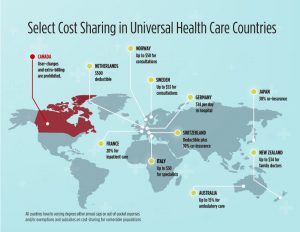
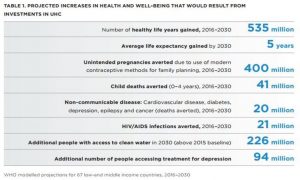
EXPECTED OUTCOMES FOR UHC:
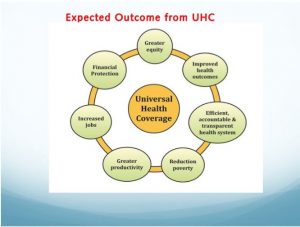
CHALLENGES FOR DEVELOPING COUNTRIES TO ACHIEVE UHC:
The term of UHC is getting popular among the countries who have not yet attained it yet there are certain challenges that creates a barrier to achieve the UHC.
- Insufficient funds: In developing countries, the external funds are the main support for universal programs. There is a challenge to reach out to the developing countries with financial aid to meet the required need.
- Financial risk protection: Financial risk protection is defined as access to all needed quality health services without financial hardship. Yet this has not been achieved due to out of pockets payment existing among the member countries.
- Reducing inefficiency: The challenge lies amongst attaining efficient provision of the services in all the sectors which is equals to impossible because of lack of efficient distribution of services.
- Reduce inequity: There is a need to consider access to services to the poor, marginalized and vulnerable population which has not yet been able to be achieved due to financial hardships.
- Mobilizing resources for health
- Use of IT for better UHC and pre-payment systems
- Improvising responsiveness, equity and quality of healthcare services
IMPORTANCE/ADVANTAGES OF UHC:
- Promotion, prevention, treatment, rehabilitation, palliative care
- Population based and personal interventions
- Interventions at different levels of the system: community, primary, secondary, tertiary.
- Gives emphasis upon maintain quality in the services of those who are getting it.
- To ensure equitable services for all who needs it and not just ones who can pay for it.
- To recognize that health depends not only on having access to medical services and a means of paying for these services but also on understanding the links between social factors, the environment, natural disasters, and health.
- Millennium Development Goals, in alleviating poverty, and in achieving sustainable development.
FACTS ON UHC:
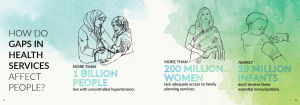
- At least half of the world’s population still do not have full coverage of essential health services.
- About 100 million people are still being pushed into “extreme poverty” (living on 1.90 USD (1) or less a day) because they have to pay for health care.
- Over 800 million people (almost 12% of the world’s population) spent at least 10% of their household budgets to pay for health care.
- All UN Member States have agreed to try to achieve universal health coverage (UHC) by 2030, as part of the Sustainable Development Goals.
- UHC does not mean free coverage for all possible health interventions, regardless of the cost.
- UHC encompasses all components of the health system: health service delivery systems, the health workforce, health facilities and communications networks, health technologies, information systems, quality assurance mechanisms, and governance and legislation and not just health financing.
- UHC is not only about ensuring a minimum package of health services, but also about ensuring a progressive expansion of coverage of health services and financial protection as more resources become available.
- UHC is not only about individual treatment services, but also includes population-based services such as public health campaigns, adding fluoride to water, controlling mosquito breeding grounds, and so on.
- UHC is comprised of much more than just health; taking steps towards UHC means steps towards equity, development priorities, and social inclusion and cohesion.
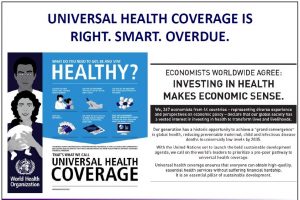
References and for more information:
http://journals.plos.org/plosmedicine/article?id=10.1371/journal.pmed.1001701
https://www.thelancet.com/journals/lancet/article/PIIS0140-6736(10)62058-2/fulltext
http://legeforeningen.no/PageFiles/240562/Universal%20health%20coverage_17.02.16_T.Ottersen.pdf
https://www.thelancet.com/journals/lancet/article/PIIS0140-6736(12)61147-7/fulltext
https://www.sciencedirect.com/science/article/pii/S0140673612611477
http://stm.sciencemag.org/content/5/199/199ed13.short
http://applications.emro.who.int/emhj/v19/04/EMHJ_2013_19_4_305_306.pdf?ua=1
https://scholar.google.com/scholar?hl=en&as_sdt=0%2C5&q=universal+health+coverage+nepal&btnG=
http://gnhe.org/blog/wp-content/uploads/2015/05/GNHE-UHC-assessment_Nepal.pdf
https://www.jppcm.org/article/53
http://www.herd.org.np/blogs/93
http://www.who.int/universal_health_coverage/en/
http://www.who.int/healthsystems/topics/financing/uhc_qa/en/
http://www.who.int/contracting/documents/QandAUHC.pdf?ua=1
http://www.worldbank.org/en/topic/universalhealthcoverage
https://www.slideshare.net/smbbs/universal-health-care-36320368
https://www.slideshare.net/HemantKumar98/universal-health-care-51380143
https://www.slideshare.net/dharmaslides/uhc-49542671
https://www.slideshare.net/souravgoswami11/universal-health-coverage-76887540
https://www.slideshare.net/dharmaslides/uhc-49542671?next_slideshow=1
https://www.slideshare.net/reyaimran/universal-health-coverage-2018